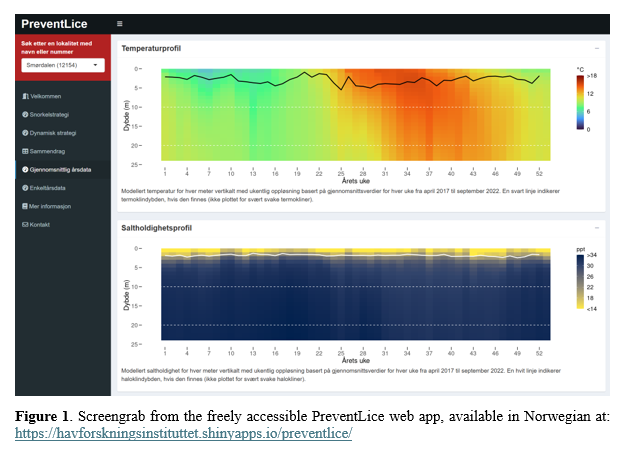PREVENTLICE: A DECISION SUPPORT TOOL FOR SEA LOUSE PREVENTION BASED ON HYDRODYNAMIC AND SITE EXPOSURE DATA
Introduction
In regions where salmon lice (Lepeophtheirus salmonis) are endemic , Atlantic salmon ( Salmo salar) farmed in open sea-cages accumulate lice , and eventually must be harvested or deloused to remain under mandated thresholds. This brings substantial animal welfare and economic costs. As most infective lice larvae are found near the surface, new infestations can be prevented or slowed by installing mesh or tarpaulin barriers at relevant depths to keep planktonic louse larvae out of the cage , by encouraging fish to swim deeper through use of deep lights and feed delivery , or by submerging the entire cage to hold fish below the depths that usually contain the most infective larvae. However, each approach has benefits and drawbacks depending on local hydrodynamic conditions and other factors. Within the FHF project PreventLice, w e compiled new and existing knowledge on how salinity, temperature, density, currents, and wave exposure affect the efficacy of barriers and deep lighting/feeding methods, and by combining this knowledge with local predictions from a national-scale hydrodynamic model, generated bespoke initial recommendations for every active salmon farm in Norway , available through a free web app and data archive. T he app is now being expanded to address the use of submerged cages, develop a universal index of wave exposure , and provide decision support for new sites as part of new FHF projects BetterWel, SafeSubmergence , and LusePraksis.
Methods
Predictors of successful use of louse barriers were identified by combining existing knowledge (meta-analysis) with new data collection targeted at identified knowledge gaps. This was done through 60 sampling visits at commercial farms distributed along the Norwegian coast throughout all seasons. For over 1000 active salmon farming sites in Norway, w e then extracted hydrodynamic and infestation pressure hindcasts from the Regional Ocean Modeling System models NorFjords160 and NorKyst800 , and made site-specific recommendations based on the alignment between modelled site conditions and thresholds for efficacy identified through meta-analysis and new data collection. The site-specific hydrodynamic data and recommendations were made available by developing a web app using the shiny package for R (Figure 1). We are now processing new data on efficacy of ‘skirt ’ barriers and submerged cages at collaborating sites , which will be used to update recommendations for use of these approaches, especially with respect to site exposure indices.
Results
‘Snorkel’ barriers reduced louse infestations by 80% or more in ideal conditions, when salinity is uniform throughout the water column , but efficacy was significantly reduced when conditions deviate from ideal. Even in ideal conditions, snorkel cages reduced growth compared to controls and lead to increased amoebic gill disease risk , and are increasingly unpopular due to these and other challenges. In contrast, dynamically deployed ‘skirt’ barriers in combination with behavior modification reduced infestations by >50% compared to standard production cages, regardless of temperature and salinity variability and without negatively impacting growth , gill health, or other welfare metrics . Efficacy of both approaches was reduced at sites with exposure to large waves , but not strongly impacted by surface current speeds of up to 0.8 m s-1. Further results will be available by the time of the conference.

